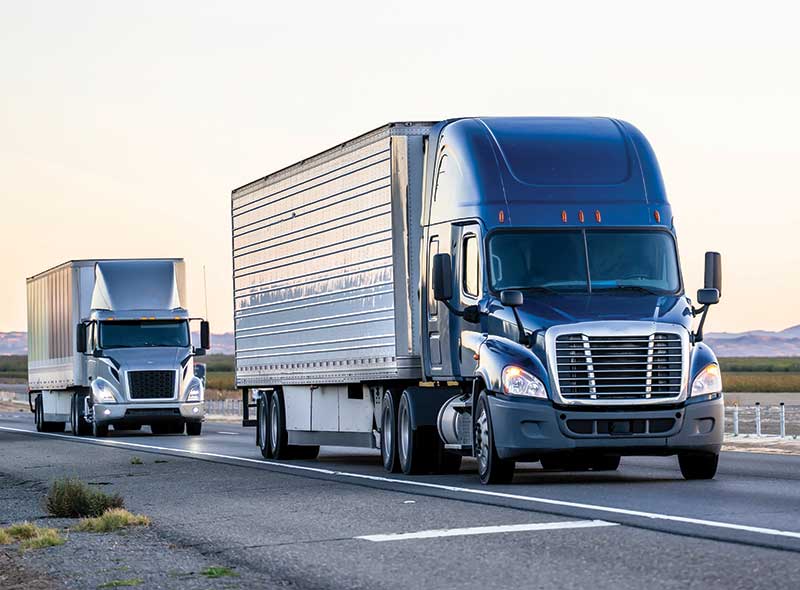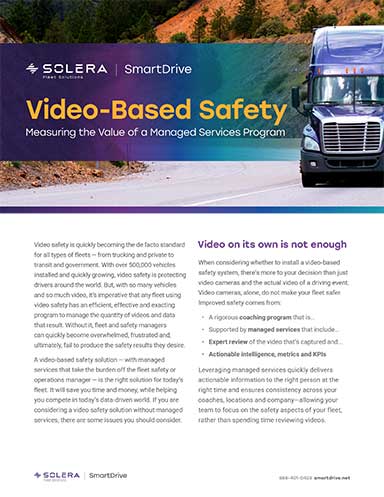Top 50 Trucking Companies 2024: Accept the challenge and adapt
The best fleets, buffeted by higher costs and now increasing environmental mandates, manage to stay ahead of competition through vision, strategy, and execution. But in the end, executives say it’s their people who make the biggest difference.
To an outsider, the Top 50 trucking companies don’t seem to change much over time. However, to those inside running the best companies in this $900 billion industry, change is occurring at breakneck speed.
Here in the early part of 2024, the biggest change coming is the push for “decarbonization” of an industry that was built on the diesel engine invented by Germany’s Rudolph Diesel in the late 1890s. But that workhorse of an engine—diesels in heavy trucks often run up to 3 million miles with regular maintenance and a rebuild or two—is facing its final end of the line.
Whether it’s a fully electric, a variety of diesel run on alternative fuels, hydrogen-powered or even battery-powered, the truck of 2035 is likely to be run on a completely different power grid than today’s traditional diesel fuel.
“I’m excited about the momentum and investment occurring in our industry relative to alternative fuel types,” says Derek Leathers, chairman, president and CEO of Werner Enterprises, the 6th-largest truckload carrier. And that comment is typical of the thinking of today’s modern trucking executives.
Top 25 Less Than Truckload (LTL) Carriers
(Annual revenue, including fuel surcharges)
| Rank | Carrier name | 2022 Revenue ( $ millions) | 2023 Revenue ($ millions) | YoY % Change (2022-2023) |
| 1 | FedEx Freight | $10,186 | $9,106 | -10.60% |
| 2 | Old Dominion Freight Line | $6,177 | $5,805 | -6.00% |
| 3 | XPO Logistics | $4,645 | $4,671 | 0.60% |
| 4 | Estes Express Lines | $4,405 | $4,218 | -4.20% |
| 5 | R+L Carriers* | $2,864 | $3,070 | 7.20% |
| 6 | Saia Motor Freight Line | $2,792 | $2,881 | 3.20% |
| 7 | ABF Freight System | $2,951 | $2,810 | -4.80% |
| 8 | TransForce (US only) | $2,957 | $2,375 | -19.70% |
| 9 | Southeastern Freight Lines | $1,741 | $1,685 | -3.20% |
| 10 | Central Transport Int’l* | $1,236 | $1,261 | 2.00% |
| 11 | Averitt Express | $1,288 | $1,165 | -9.50% |
| 12 | Dayton Freight Lines | $1,056 | $1,035 | -2.00% |
| 13 | Pitt Ohio Transportation Group | $912 | $909 | -0.30% |
| 14 | Forward Air | $969 | $846 | -12.70% |
| 15 | AAA Cooper Transportation* | $727 | $764 | 5.10% |
| 16 | A. Duie Pyle | $568 | $570 | 0.40% |
| 17 | Roadrunner Transportation | $400 | $410 | 2.50% |
| 18 | Daylight Transport | $389 | $374 | -3.90% |
| 19 | Oak Harbor Freight Lines* | $338 | $320 | -5.30% |
| 20 | Ward Trucking Corporation | $256 | $253 | -1.20% |
| 21 | Cross Country Freight Solutions | $187 | $207 | 10.60% |
| 22 | Midwest Motor Express* | $153 | $160 | 4.60% |
| 23 | Magnum LTL | $152 | $155 | 2.00% |
| 24 | Sutton Transport | $112 | $123 | 9.80% |
| 25 | Dependable Highway Express | $131 | $112 | -14.50% |
| Top 25 excluding Yellow | $47,592 | $45,285 | -4.80% | |
| Yellow Corp. (closed in Aug)*** | $5,245 | $2,423 | -53.80% | |
| TOTAL TOP 25 US LTL CARRIERS | $52,837 | $47,708 | -9.70% | |
| ALL OTHER US LTL CARRIERS* | $4,841 | $4,641 | -4.10% | |
| TOTAL US LTL MARKET^ | $57,678 | $52,349 | -9.20% | |
*SJC estimates
**With lower FSC in 2023, LTL market size ex-FSC in 2023 declined by 4.5% instead of 9.2%
***While Yellow’s demise in August 2023, the average daily shipments handled by other carriers thereafter
are not fully reflected in their average daily shipment count
^ 2022 market size revised to exclude TFI Canada
Prepared by SJ Consulting Group, Inc.
Today, they don’t fight change; they embrace it. While there are still plenty of old-school executives in today’s trucking C-suites, they’re being replaced often by highly educated leaders who bring out the best in their employees.
“At its core, our industry is about people,” says Kent Williams, executive vice president of sales and marketing for Averitt Express, the 12th-largest LTL carrier and a Southeast-based regional trucking behemoth. “Averitt’s real strength lies not just in our service, but in the dedicated and passionate individuals we bring onboard.”

So, let’s take a look at some of those people behind the 50 largest trucking companies in America—Top 25 truckload and Top 25 less-than-truckload (LTL)—that comprise Logistics Management’s annual deep dive into the top carriers in the nation.
Knight-Swift continues march into LTL market
Knight-Swift Transportation, already the largest truckload carrier in the U.S. with more than $4.5 billion in revenue, is poised to make a huge splash in the less-than-truckload (LTL) market as well.
Knight-Swift Transportation Holdings has agreed to pay around $2.2 million to acquire 10 Yellow Corp. terminal leases, mostly in the western U.S.—three in Idaho, two in Colorado, two in Kansas, one in Missouri, one in Nebraska, and one in Georgia.
Rival companies have spent nearly $2 billion to acquire Yellow properties for its strategic terminal assets. Yellow sold 128 properties and 25 leases, with most of the buyers being LTL carriers.
Knight-Swift, traditionally in the truckload business, entered the LTL sector in 2021. The carrier said it plans to provide national LTL service by the end of 2025.
- John D. Schulz, contributing editor
Vision, strategy or execution?
Ask any of the CEOs who manage the best-run trucking fleets in American what’s the most important element in their day-to-day operations and you usually get a cross-section of answers involving vision, planning, day-to-day execution, operations and people skills.
“It is all of the above,” says Chuck Hammel, president of Pitt Ohio, a top-flight regional and interregional LTL carrier. “You create your strategy based on customer needs and market demands of your customer. These are constantly changing, so you need to be agile. Then you need to execute at a high level.”
So, how do you do it? “The key to any successful company comes down to your selection of employees and how you nurture them,” says Hammel.
Service today means much more than just picking up and delivering freight to customers on-time and claims free. Other attributes that shippers consider when selecting a carrier are metrics such as consistent transit times, carrier trustworthiness, and ease of doing business.
Consulting firm Mastio & Co. conducts a comprehensive LTL study each year that measures carriers on 28 different service and value-related attributes. Averitt Express was ranked on top with the highest overall score this year.
“At its core, our industry is about people,” Averitt’s Williams explains. “Averitt’s real strength lies not just in our service, but in the dedicated and passionate individuals we bring onboard. We make it our mission to seek out the brightest minds, nurture their talents and create a culture where they can flourish.”
Old Dominion Freight Line (ODFL) scored at the top in 25 of the 28 of Mastio’s individual attributes. “At a base level, it all begins with service,” says Greg Plemmons, ODFL’s chief operating officer. “You have to be committed to providing premium service. Everything else derives from that. How does that manifest itself? All our 22,000 people have to understand their role in providing that service.”
Top 25 Truckload Carriers
| Rank | Carrier name | 2023 Revenue ($ million) | 2022 Revenue ($ millions) | YoY % Change (2022 - 2023) |
| 1 | J.B. Hunt Transport Services | $4,332 | $4,461 | -2.90% |
| 2 | Knight-Swift Transportation* | $3,910 | $4,531 | -13.70% |
| 3 | Schneider National | $2,640 | $2,787 | -5.30% |
| 4 | Prime | $2,524 | $2,605 | -3.10% |
| 5 | Landstar System | $2,323 | $3,081 | -24.60% |
| 6 | Werner Enterprises | $2,282 | $2,402 | -5.00% |
| 7 | Penske Logistics | $2,200 | $2,300 | -4.30% |
| 8 | Ryder Systems | $1,785 | $1,786 | -0.10% |
| 9 | U.S. Xpress Enterprises* | $1,698 | $1,825 | -7.00% |
| 10 | CRST International* | $1,668 | $1,853 | -10.00% |
| 11 | Crete Carrier Corp.* | $1,342 | $1,525 | -12.00% |
| 12 | Daseke* | $1,277 | $1,398 | -8.70% |
| 13 | Heartland Express | $1,207 | $968 | 24.70% |
| 14 | CR England | $1,089 | $1,209 | -10.00% |
| 15 | NFI Industries | $1,100 | $1,100 | 0.00% |
| 16 | Western Express* | $1,054 | $1,138 | -7.40% |
| 17 | PS Logistics* | $1,008 | $1,104 | -8.70% |
| 18 | Ruan Transportation* | $937 | $985 | -9.00% |
| 19 | Marten Transport | $874 | $930 | -6.00% |
| 20 | KLLM* | $867 | $953 | -9.00% |
| 21 | Cardinal Logistics* | $850 | $821 | 3.50% |
| 22 | Hirschbach Motor Lines | $808 | $735 | 9.90% |
| 23 | Stevens Transport* | $765 | $841 | -9.00% |
| 24 | Covenant Transportation Group | $696 | $752 | -7.40% |
| 25 | Anderson Trucking Service* | $675 | $750 | -10.00% |
| TOTAL FOR TOP 25 CARRIERS | $35,578 | $42,810 | -16.90% | |
Costs relentlessly increasing
The costs of doing business as a motor carrier have never been higher. ACT Research estimates that tightening federal and state-required emissions regulations, labor costs and other factors will cause medium- and heavy-duty vehicle costs to rise by between 12% and 14%.
The industry experienced record-high costs in 2022, the last full year statistics are available. Trucking endured a whopping 21.3% increase in operational costs over the previous year—and the expectation is that the cost to operate a truck will remain above $2.00 per mile for the foreseeable future.

Inflation caused interest rates to rise for borrowing rates and the cost of capital. Meanwhile, pricing in all trucking sectors fell steadily last year, hampered by a poor agricultural season, generally flat housing and manufacturing and retail sales that were outpaced by inflation as retailers remained overstocked.
Total number of jobs in trucking began to fall last year for the first time since the start of the pandemic, and the number of registered carriers remained nearly flat after years of growth.
According to the American Truck Research Institute (ATRI), truckers’ concern over the state of the nation’s economy rose four spots this year to be the top-ranked industry issue this year. It was listed among the top 10 concerns for both trucking executives and drivers, according to ATRI.
There’s good reason for this mounting concern. The Environmental Protection Agency’s Clean Trucks regulation goes live in 2027, unless the EPA postpones it. In the meantime, large fleets are expected to begin pre-buying their 2027-compliant engines with the 2024 model year.
According to reports, original equipment manufacturers (OEMs) have been successful in marketing the new engines, and this pre-buying should help moderate what’s expected to be runaway demand. But if economic circumstances force the OEMs to cut production this year, market analysts say that supply-chain integrity could be compromised.
To help manage costs, Werner is investing in new equipment to cycle out older trucks. A year ago, Werner had over 500 trucks that each had over 400,000 miles. However, the number of those high-mileage trucks has been reduced to 50, according to company CEO, president and chairman Derek Leathers. Werner runs nearly 8,300 trucks.
“We’re still continuing to work more aggressively on in-house maintenance, quality of that maintenance, but also the fresher fleet gives us a pretty good head start on that,” says Leathers.
Alternative fuels
The California Air Resources Board’s (CARB) Advanced Clean Truck rule requires medium- and heavy-duty vehicle manufacturers to sell zero-emission trucks as an increasing portion of total sales within California from 2024 to 2035. Other states are sure to follow. Some trucking executives are rebelling at such mandates; however, some top fleet executives are taking the opposite approach. Werner’s Leathers, for example, says he’s “excited” about the possibilities of some of the alternative fuels.
Among the choices are renewable diesel, which is in use today and is increasing across the industry. It’s made from multiple feedstocks that can either replace diesel entirely or blended in any amount.
Another choice is renewable natural gas. It’s a biogas that comes from a variety of sources, including landfills, water purification facilities and livestock farms. The Cummins X15N natural gas engine is being used in testing phases by many of the leading trucking fleets.
Hydrogen engines provide opportunities to reduce emissions. It’s expected to increase in testing among many fleets. The best fleets tend to have the youngest fleets—Werner’s trucks, for example, average close to two years old, allowing the latest technology to run over the road.
Batteries are a possibility for some fleets. For utility company trucks, for example, they’re ideal because they can be repowered at night. However, the weight of the battery pack is prohibitively heavy for a fully loaded 80,000-pound truck to travel long distances.

The future of fuel
Ultimately, trucking executives say that there are benefits and challenges to each of these alternative technologies. But of more immediate concern is the handling of millions of loads each day when shippers expect near-flawless delivery schedules.
Some carrier executives are agnostic as to which alternative fuel eventually will win out. All they ask is that it
be plentiful, reliable, cost effective, and readily adaptable—easier said than done.
“In the meantime, our customers expect us to pick up and deliver safely and on time, every time,” says Werner’s Leathers. “We will stay at the forefront of testing and investing in alternative fuel sources, but we remain agnostic and flexible as the most viable options emerge. Either way, we’ll be ready.”
“I don’t favor one fuel over the other,” says Pitt Ohio’s Hammel. “However, it needs to work in our operation and be cost effective.”
The way Hammel and others see it, the trucking industry has been decarbonizing for more than 25 years. “We’ve gone from dirty diesel engines that would get three miles per gallon to clean diesel engines that would get 7 miles per gallon to compressed natural gas (CNG) to electric and soon to be hydrogen. Each step along the way we’ve lowered our carbon output,” he said.
Pessimists see change, and complain. Optimists accept whatever challenge is next and adapt. Clearly, the best trucking companies (and
executives) are in the latter category.













